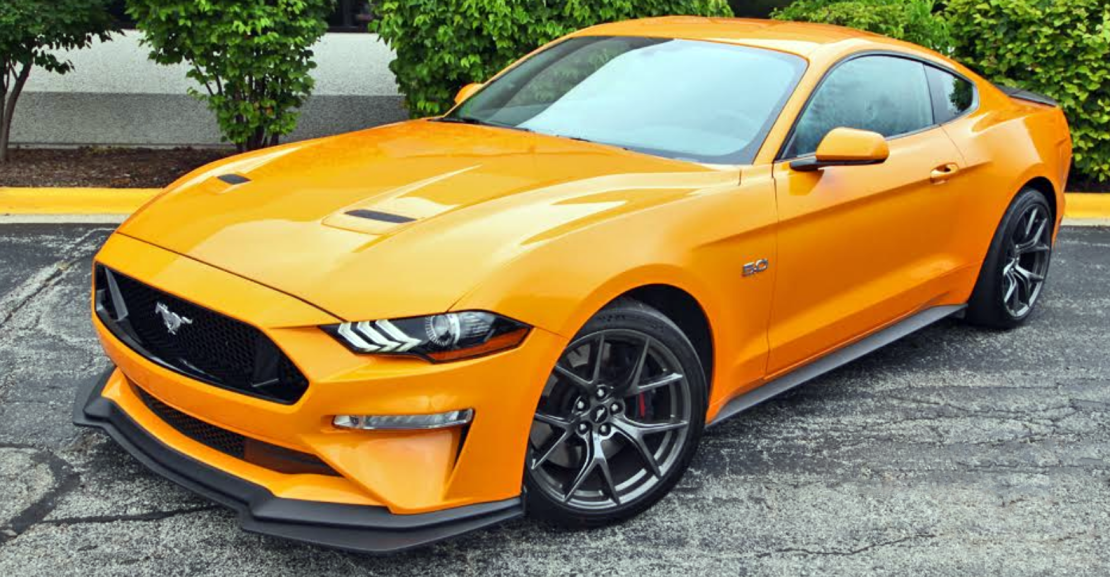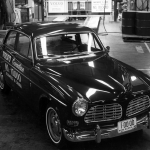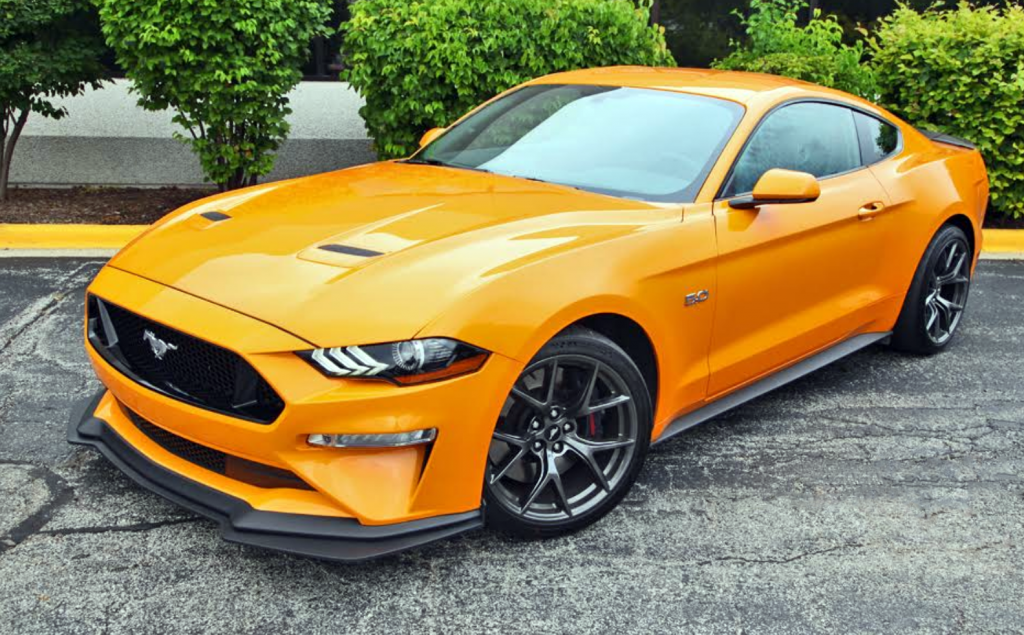
 2018 Ford Mustang GT with Performance Pack 2
2018 Ford Mustang GT with Performance Pack 2
Class: Sporty/Performance Car
Miles driven: 327
Fuel used: 21.3 gallons
Real-world fuel economy: 15.4 mpg
Driving mix: 50% city, 50% highway
| CG Report Card | |
|---|---|
| Room and Comfort | B- |
| Power and Performance | A |
| Fit and Finish | B- |
| Fuel Economy | D+ |
| Value | B- |
| Report-card grades are derived from a consensus of test-driver evaluations. All grades are versus other vehicles in the same class. Value grade is for specific trim level evaluated, and may not reflect Consumer Guide's impressions of the entire model lineup. | |
| Big & Tall Comfort | |
| Big Guy | B- |
| Tall Guy | B- |
| Big & Tall comfort ratings are for front seats only. "Big" rating based on male tester weighing approximately 350 pounds, "Tall" rating based on 6'6"-tall male tester. | |
EPA-estimated fuel economy: 15/25/18 (city, highway, combined)
Base price: $35,095 (not including $900 destination charge)
Options on test vehicle: Equipment Group 301A ($2000), special paint ($495), Performance Package – Level 2 ($6500), Active Valve Performance Exhaust ($895)
Price as tested: $45,885
Quick Hits
The great: Ferocious acceleration; racetrack-ready handling; good ol’ muscle-car swagger
The good: Decent interior room for a sporty coupe
The not so good: Fuel economy; Performance Pack 2 goodies tack on a hefty price premium, and compromise ride quality and tractability in everyday driving
More Mustang price and availability information
John Biel
The Mustang has been around for more than half of a century but Ford continues to give loyalists opportunities to see its sporty fastback coupe and convertible in new ways. For 2018 the sixth-generation pony freshens up with revised front and rear fasciae, a lower hood with new-style vents, and LED lights all around. There’s a new available 10-speed automatic transmission; a significant power gain for the V8 in GT models; and expanded comfort, convenience, and driver-assistance/safety features.

As a midyear bonus, Ford slipped in a “Level 2” Performance Package (PP2) option for GT coupes with the 6-speed manual transmission. It builds on features from the basic Performance Package—big 6-piston Brembo front disc brakes, larger radiator, suspension and chassis-bracing enhancements, and oil-pressure/engine-vacuum gauge pack—by adding wider staggered-width 19-inch alloy wheels, Michelin Pilot Sport Cup 2 performance tires, distinct front air splitter and rear spoiler, “MagneRide” adaptive dampers, and a Torsen limited-slip differential with 3.73:1 axle ratio.
Test Drive: Chevrolet Camaro 1LE V6
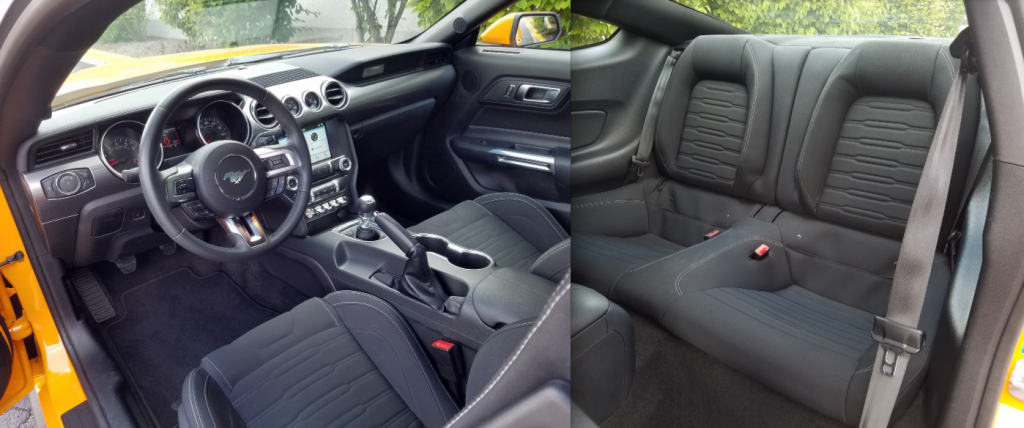
Consumer Guide® editors got to sample much of what’s new in the ’18 Mustang when they drove a GT coupe with the Performance Package 2. (Even the paint, a showy Orange Fury Metallic, was one of three new colors for the year.) The test car was a base-trim cloth-upholstery GT with a starting price of $35,995 with delivery, but optioned up to $45,885, figures that are in line with what chief competitors Chevrolet and Dodge respectively charge for Camaro and Challenger models with naturally aspirated V8s.
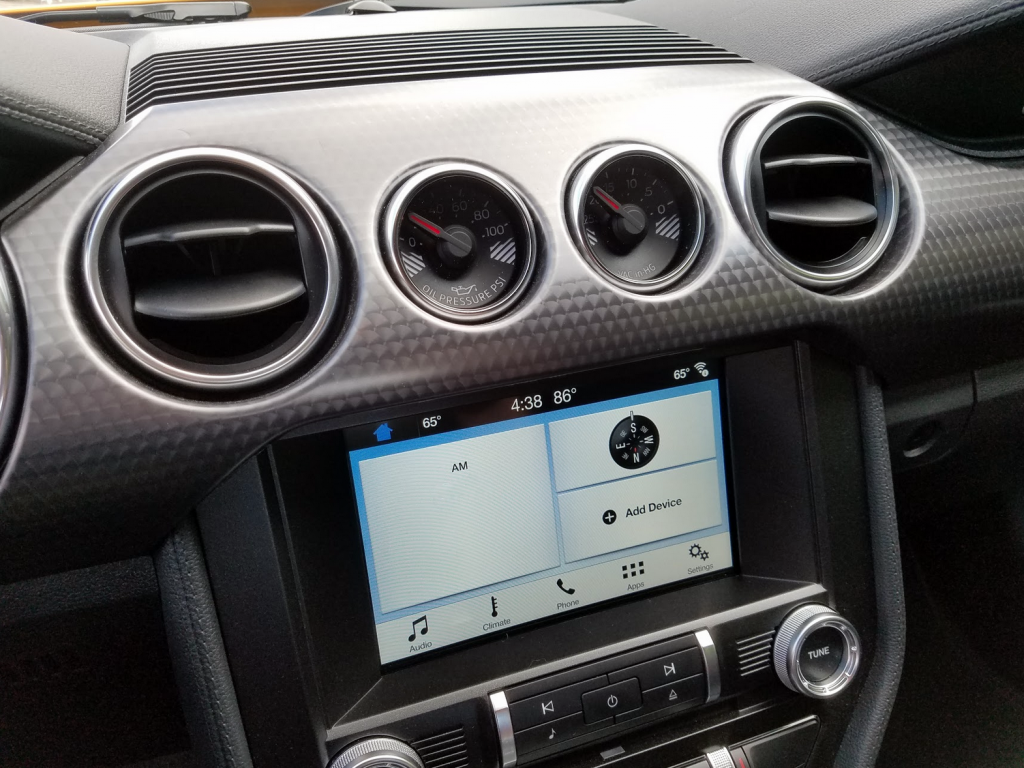
The GT’s 5.0-liter engine picks up 25 horsepower for a rating of 460 at 7000 rpm when fed 93-octane gasoline. In the latest leg of the horsepower race that puts the Mustang well ahead of the Challenger R/T’s 375 from the 5.7-liter Hemi and slightly in front of the Camaro SS’s 455 from 6.2 liters, but still behind the 485 horsepower generated by the 6.4-liter Hemi in the Challenger Scat Pack and SRT jobs. Also, torque increases to 420 lb-ft at 4600 rpm, a 5-percent gain.
The horsepower and torque peaks arrive at slightly higher rev levels than they did previously, but there’s nothing holding the Mustang GT back on the way up there. Ford mixes high-pressure direct injection and low-pressure port injection in the GT mill to keep it humming throughout the range. Pressure on the throttle is answered immediately from a standstill and acceleration rises in a long, straight line. One of the toggle switches at the bottom of the instrument panel adjusts drive modes, and clicking up from “Normal” to “Sport” appreciably quickens response. (More specialized “Track,” “Drag Strip,” and “Wet/Snow” modes are also included.) There’s abundant passing power on tap, and highway cruising is unlabored—all the better for taking in the performance-car warble from the optional active-valve exhaust.
The 6-speed manual gearbox has well-spaced ratios, and shifts are made cleanly with fairly short throws. The last time this driver got behind the wheel of a gen-6 GT in 2015 he found the firm clutch pedal tricky to modulate for smooth starts, but the 2018 model was better in that regard. The current 5.0/6-speed powerteam has EPA fuel-economy ratings of 15 mpg in the city, 25 on the highway, and 18 combined. This reviewer recorded 15.4 mpg after logging 205.2 miles with 51 percent city-style driving—a solid improvement over his 2015 experience that had a higher percentage of city operation.
Shifting Rivalry: Camaro and Mustang to Share 10-Speed Transmission
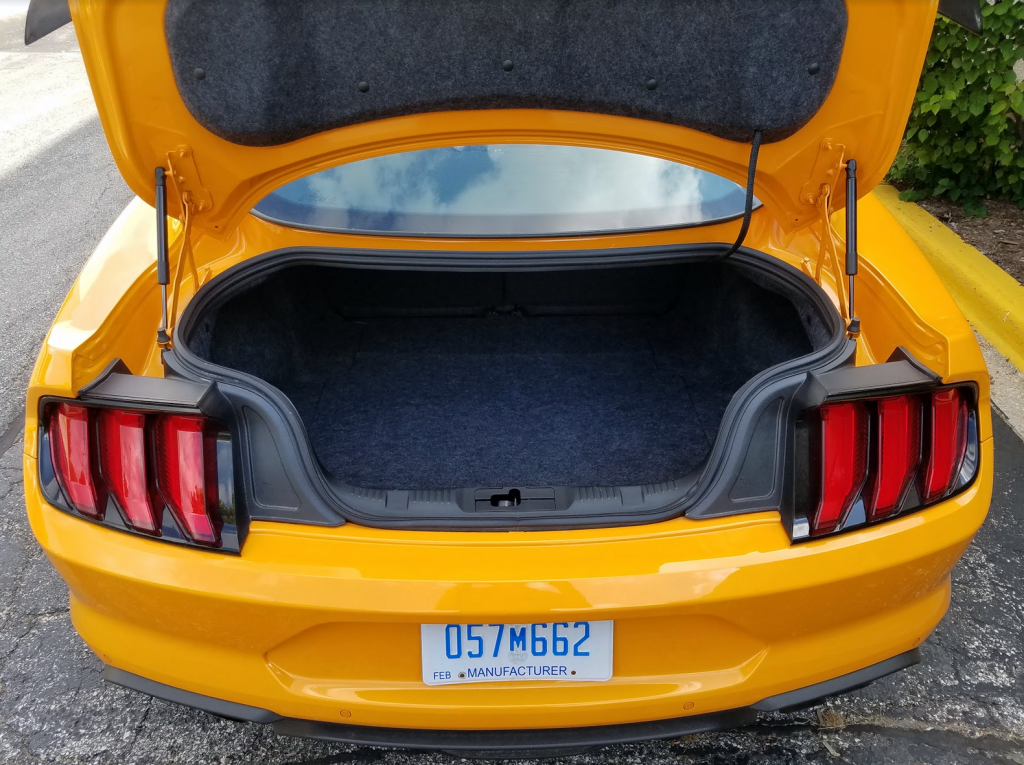
Ride from the fully independent suspension is uncompromisingly firm, and gets a bit more so in Sport mode—enough to induce solid jolts over road cracks. Steering starts out pretty crisp and responsive in the Normal setting but sharpens its focus in Sport. (Another dash switch allows drivers to choose one of three levels of steering feel independently of the drive-mode selector.) The Mustang GT corners fairly flat, with fine turn-in in Sport mode, though the back end kicked up moments of bumpy side skitter for this driver in some tighter bends. Stopping power from the uprated brakes is another plus point.
A base-trim GT skimps on interior luxury. Soft-touch surfaces are limited to the door armrests, console-box lid, visors over the instrument cluster and glove box, and leather-wrapped steering wheel and parking-brake handle. The test car was equipped with Recaro sport seats that provide secure side bolstering handy for aggressive driving but at the cost of some of the car’s limited convenience features. The standard seats are power adjustable with lumbar support but the sport seats (a no-cost option) are manually adjusted and lack lumbar controls.
The test car was optioned up with dual-zone climate control, satellite radio, and the Sync 3 version of Ford’s infotainment system, all of which are standard in the plusher leather-upholstered GT Premium that starts at $4000 more. Sync 3 displays well and is easy to use, especially for audio settings. The temperature adjusters on the dual-zone climate unit look like they are direct controls that can be pushed right to a desired level of heating or cooling, but they are, unfortunately, repetitive-push toggles.
Even with its rakish roofline, the Mustang still boasts the best driver vision of all the domestic sport coupes. The front half of the cabin is cozy but not confining, though tall drivers might be squeezed for headroom. As for the back, you’re only going to sit back there if you’re a jockey—fitting for something named after a horse, come to think of it. Interior storage includes a usefully sized glove box, two exposed cup holders in the console, long door pockets, and a small console cubby with media-device inputs within.
Pony-Car Madness! 10 Classic Mustang Ads
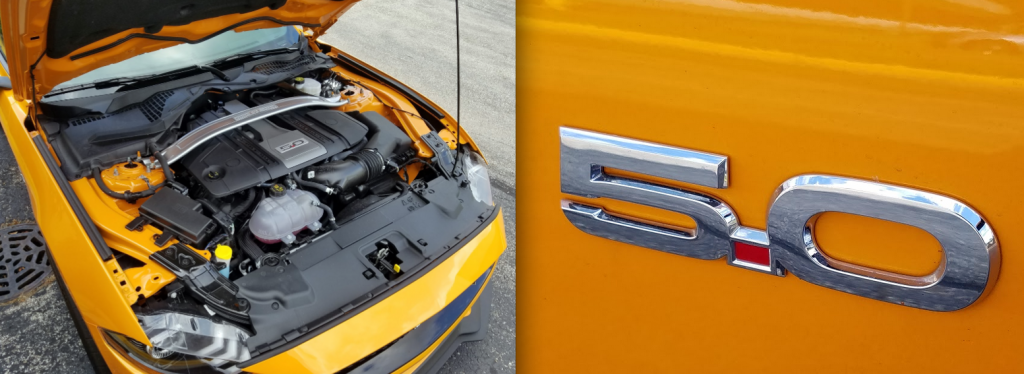
The trunk has a wide lid but a high liftover. Space on the flat floor extends well forward, but isn’t very tall. Fortunately, the decklid raises on body-mounted pistons rather than gooseneck hinges that would intrude on the trunk space. Room exists around the air compressor in the spare-tire well for additional items if needed. Rear 60/40 seats fold for added cargo space but they rest above the level of the trunk floor, and a fixed interior package shelf over a bulkhead restricts the size of items that pass from the trunk.
The nameplate may be comfortably familiar but Ford continues to find ways to keep the Mustang feeling new.
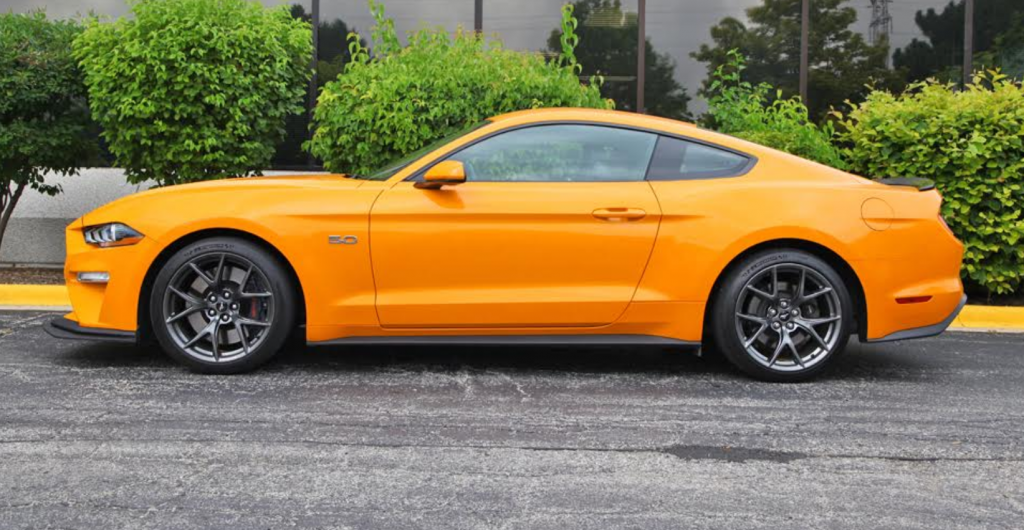
First Spin: 2019 Dodge Challenger SRT Hellcat Redeye and Dodge Challenger R/T Scat Pack

